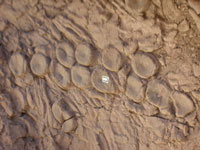New evidence from Nevada points to Triassic kraken.
About 225 million years ago, the oceans of Earth were roamed by gigantic, air-breathing reptiles. Snaggle-toothed ichthyosaurs larger than school buses swam at the top of the Triassic Period ocean food chain, or so it seemed before Mount Holyoke College paleontologist Mark McMenamin took a look at some of their remains in Nevada.
Now he thinks there was an even larger and more cunning sea monster that preyed on ichthyosaurs: a kraken of such mythological proportions that it would have sent Captain Nemo off to dry land. The evidence lies at Berlin-Ichthyosaur State Park in Nevada, where McMenamin and his daughter spent a few days last summer.
A site of confusion
It’s a site where the remains of nine 45-foot (14-meter) ichthyosaurs belonging to the species Shonisaurus popularis can be found. These were the Triassic’s counterpart to today’s predatory giant squid-eating sperm whales. But the fossils at the Nevada site have a long history of perplexing researchers, including the world’s expert on the site: the late Charles Lewis Camp of U.C. Berkeley.
“Charles Camp puzzled over these fossils in the 1950s,” said McMenamin. “In his papers he keeps referring to how peculiar this site is. We agree – it is peculiar.”
Camp’s interpretation was that the fossils probably represented death by an accidental stranding or from a toxic plankton bloom. But no one had ever been able to prove that the beasts died in shallow water. In fact, more recent work on the rocks around the fossils suggest it was a deep water environment, which makes neatly arranged carcasses even more mysterious.
This question – shallow or deep ocean death – is what attracted McMenamin to the site.
“I was aware that anytime there is controversy about depth, there is probably something interesting going on,” he admitted. And indeed, when they arrived at the remote state park and started looking at the fossils, McMenamin was struck by their strangeness. “It became very clear that there was something unusual there, particularly in the configuration of bones.”
Initial clues
First of all, the different degrees of etching on the bones suggested that the shonisaurs were not all killed and buried at the same time. It also looked like the bones had been purposefully rearranged. That got him thinking about a particular modern predator that is known for just this sort of intelligent manipulation of bones.
“Modern octopus will do this,” McMenamin said. So what if there was an ancient, very large sort of octopus, like the kraken of mythology? “I think that these ichthyosaurs were captured by the kraken and taken to the midden where the cephalopod would take them apart.”
In the fossil bed, some of the shonisaur vertebral disks are arranged in curious linear patterns with almost geometric regularity, McMenamin explained. The proposed Triassic kraken, which could have been the most intelligent invertebrate ever, arranged the vertebral discs in double line patterns, with individual pieces nesting in a fitted fashion as if they were part of a puzzle.
It gets even more creepy! The arranged vertebrae resemble the pattern of sucker discs on a cephalopod tentacle, with each vertebra strongly looking like a coleoid sucker. In other words, the vertebral disc “pavement” seen at the state park may represent the earliest known self-portrait!
Modern day evidence
But could an octopus really have taken out such huge swimming predatory reptiles? No one would have believed such a tale until the staff of the Seattle Aquarium set up a video camera at night a few years ago to find out what was killing the sharks in one of their huge tanks. They were shocked to discover that the culprit was a large octopus sharing their quarters.
“We now think that this cephalopod in the Triassic was doing the same thing,” said McMenamin. Among the evidence for kraken attacks are many more ribs broken in the shonisaur fossils than would seem accidental, combined with the twisted necks in other cases. “It was either drowning them or breaking their necks.”
Of course, it’s the perfect Triassic crime because octopuses are mostly soft-bodied and do not fossilize well. Only their beaks, or mouthparts, are hard and the chances of those being preserved nearby are very low. That means the evidence for the murderous kraken is circumstantial, which may leave some scientists rather skeptical. But McMenamin is not worried. “We have a very good case,” he said confidently.



